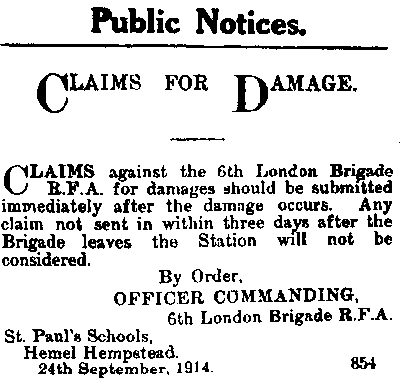The Council at War
Chapter 9
The Troops Arrive
The First Wave of Troops Depart
After months of speculation as to how long the troops would remain The Gazette was able to report, on 20th March, 1915:
At last the 7th Brigade, which had been stationed at Boxmoor, left, but they did not go any further than Cassiobury Park, Watford. Then on Saturday night and early Monday morning the 5th Brigade had headquarters in the High Street, departed followed by the two batteries of the 8th Brigade, stationed at Apsley, and on Monday night and early Tuesday morning by the 6th Brigade, which had been stationed in the upper part of the town. They all re-trained at Berkhamsted,- where exactly for no one knew at the time. All that is known is that the Brigades appear to have reached one of those elusive and unidentified places designated “Somewhere” on the Continent, about which we have heard so much since the war began. ....
The conduct of the troops during their lengthy stay has been exceedingly good, and there can be no question but that the trade of the town has derived enormous benefit from their presence. In fact, it would be hard to say who has not benefited either directly or indirectly. ...
There are numerous rumours about further troops being billeted in the town, but whether this is so or refers merely to those who are to occupy the camp at Gadebridge remains to be seen. At any rate it is certain that a considerable body of troops will be kept in the vicinity for some time to come, so the trade in the town may look forward for a continuance of prosperity in preparation for the hard times which in all probability will be felt for a year or so after peace has been declared.
The Town did not have long to wait for further soldiers to arrive. It was only a matter of days before the artillery of the 2nd London (Reserve) Division arrived and Mr Rawson could report that one enthusiastic householder had taken on six soldiers, bringing the total number of people living in a four bedroomed house to twenty six! He explained that it was impossible for him to inspect every house in the district when the troops swarmed down. The Medical Officer of Health, Dr Gruggen, said that the soldiers were supposed to have 40 square feet each and the authorities expected every billet to be inspected once a week, which was clearly impossible. Three months later Mr Rawson said he had recently visited 164 billets and cookhouses. Alderman Bailey commented that there were about 100 soldiers in The Old House, on the Broadway, and Mr Rawson said that they might get 20 soldiers billeted in one room. Such problems continued throughout the War and in May 1917 Mr Rawson reported that he had inspected 250 rooms in the previous three weeks, and 20% were overcrowded for either the soldiers or the occupying family.
| The departing troops also left damaged property. When the first batch of troops left for France in March 1915 the Walter Locke had to contact the military authorities in St Albans about the damage to school buildings. A year later he had to report that the Town Hall premises recently vacated by the military were left in a very dirty condition and considerable damage had been done. The Manse in Alexandra Road was slightly damaged by fire in April 1915, and in June the Sanitary Inspector reported that 40 troops were billeted there and the faulty drains appeared to have been deliberately blocked by the previous battery to occupy the premises. |
 |
|
| August 2014 | Page Created |

